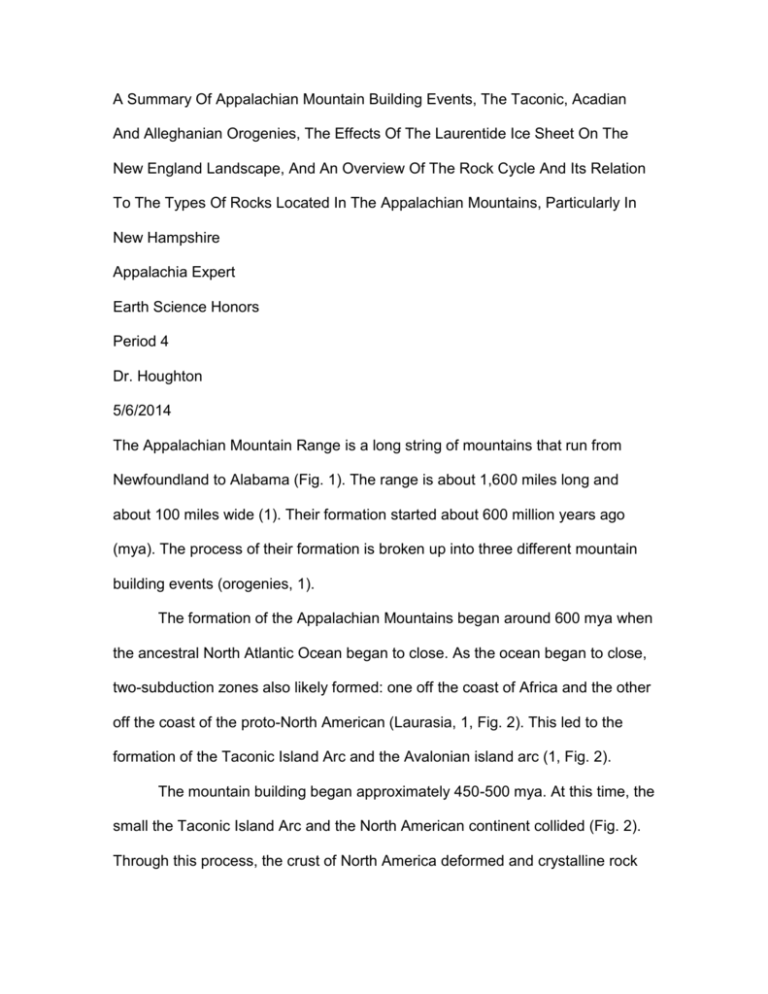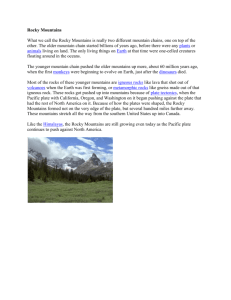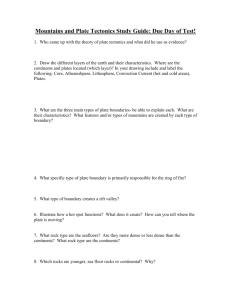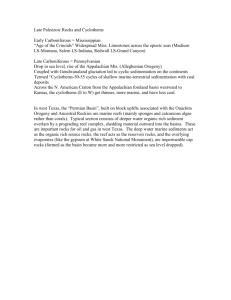Earth Science Honors - Student Exemplar 2
advertisement

A Summary Of Appalachian Mountain Building Events, The Taconic, Acadian And Alleghanian Orogenies, The Effects Of The Laurentide Ice Sheet On The New England Landscape, And An Overview Of The Rock Cycle And Its Relation To The Types Of Rocks Located In The Appalachian Mountains, Particularly In New Hampshire Appalachia Expert Earth Science Honors Period 4 Dr. Houghton 5/6/2014 The Appalachian Mountain Range is a long string of mountains that run from Newfoundland to Alabama (Fig. 1). The range is about 1,600 miles long and about 100 miles wide (1). Their formation started about 600 million years ago (mya). The process of their formation is broken up into three different mountain building events (orogenies, 1). The formation of the Appalachian Mountains began around 600 mya when the ancestral North Atlantic Ocean began to close. As the ocean began to close, two-subduction zones also likely formed: one off the coast of Africa and the other off the coast of the proto-North American (Laurasia, 1, Fig. 2). This led to the formation of the Taconic Island Arc and the Avalonian island arc (1, Fig. 2). The mountain building began approximately 450-500 mya. At this time, the small the Taconic Island Arc and the North American continent collided (Fig. 2). Through this process, the crust of North America deformed and crystalline rock began to form from the remnants of the collision. This formed the first of the mountains added to the Appalachian mountain chain, the Western Piedmont region and Blue Ridge Mountains (1). This was known as the Taconic Orogeny (2, Fig. 2). The second part of the mountain building process happened 400 mya. During this process the Ancestral North Atlantic continued to close and the Avalonian arc collided with the Proto-North American continent. The islands were added to the existing start of mountains, and caused them to grow larger. The subduction zone that was present near the Avalonian Island Arc was now located off coast of North America (1). This process is known as the Arcadian Orogeny (2, Fig. 2). The third and final Orogeny occurred 250-300 million years ago. This final step resulted in the collision of the Proto-North American Continent with the Proto-African and European Continents. The African Plate and North American Plate formed a convergent boundary, where the African Plate slid underneath the North American Plate. The convergent boundary then connected the North American Continent with the African continent. The force of one plate sliding under the other resulted in the upward force of the North American Boundary that in turn formed the remainder of the Appalachian Mountains (1). This final Orogeny is known as the Allegheny Orogeny (2, Fig. 2). During the formation of the Appalachian Mountains, the rocks that make up the mountains went through many changes (Fig. 3). There are three types of rocks: igneous, metamorphic and sedimentary (1, Fig. 3). Igneous rocks are formed when hot magma cools and crystallizes. There are two types of igneous rocks, intrusive and extrusive igneous rocks. Intrusive cool very slowly and usually contain a large amount of crystal while extrusive cool almost immediately and contain little to no crystals (1, Fig. 3). Metamorphic rocks are made from preexisting rocks that are usually changing from one rock type to another (1, Fig. 3). Sedimentary rocks form when sediments are compacted and cemented. Weathering and erosion over time helps these rocks settle and form into the sedimentary rocks (1, Fig. 3). All three rocks can go through a series of changes, in what is known as the rock cycle. During the cycle many factors, such as weathering, erosion, melting and crystallization affect and change rocks from one form to another (1, Fig. 3). Before the continents moved to their current position, all the continents likely were connected in one supercontinent known as Pangaea (3, Fig. 4). Each continent was located on a floating piece of land known as a plate. The plates, which are located in the lithosphere, are constantly in motion. The continents on each plate have drifted apart over the past 300 millions years (3). The three mountain building events (Orogenies) led to the landmasses of North America and Africa combining to form Pangaea. There were many sedimentary rocks that formed on the bottom of the ocean that were forced up to form part of the Appalachian Mountains. As the plates collided, the African Plate gave way and slid under the North American Plate. The sedimentary rocks built up over time and formed the huge mountains. But because of all the squeezing and compressing of the rocks, heat was generated and eventually much of the sedimentary rock underwent metamorphosis and turned into metamorphic rock (Fig. 3). This is the reason that New Hampshire rocks are metamorphic and not sedimentary (3). Though, many sedimentary rocks remain throughout the Appalachian Mountains. The Appalachian Mountains have undergone drastic changes since their formation mya. The most recent changes include glaciation, and weathering and erosion. About 55,000 and 18,000 years ago, the Laurentide Ice Sheet covered Canada and all of New England in ice (Fig. 5). When glaciers move they carry loose rocks and sediments with them and can transport them great distances. The Laurentide ice sheet was the main cause of many large rock deposits located around New England (4). Work Cited: 1) Tarbuck, Edward J., and Frederick K. Lutgens. Earth Science. Upper Saddle River, NJ: Prentice Hall, 1997. Print. 2) "Building the Northern Appalachian Mountains and New England - Jamestown RI Visitor Information." Jamestown RI. Web. 08 Apr. 2012. <http://www.jamestown-ri.info/northern_appalachians.htm>. 3) Hoffman, Doug L. "The Resilient Earth." Appalachian Mountains Rock Ice Age. 12 Nov. 2009. Web. 08 Apr. 2012. <http://www.theresilientearth.com/?q=content/appalachian-mountains-rock-iceage>. 4) Rittenour, Tammy M. "ICE AGES IN NEW ENGLAND." Ice Ages in New England. Web. 10 Apr. 2012. <http://www.bio.umass.edu/biology/conn.river/iceages.html>. 5) "Landforms of North America, Mountain Ranges of North America, United States Landforms, Map of the Rocky Mountains - Worldatlas.com." Landforms of North America, Mountain Ranges of North America, United States Landforms, Map of the Rocky Mountains - Worldatlas.com. N.p., n.d. Web. 08 May 2014. 6) "Alleghanian Orogeny." Wikipedia. Wikimedia Foundation, 04 Aug. 2014. Web. 08 May 2014. 7) "The Rock Cycle." The Rock Cycle. N.p., n.d. Web. 08 May 2014. 8) "Plate Tectonics." Plate Tectonics. N.p., n.d. Web. 08 May 2014. 9) "Glaciers; Where It All Began - Acadia National Park." Glaciers; Where It All Began - Acadia National Park. N.p., n.d. Web. 08 May 2014. Figure 1. Major Mountain Ranges of the North American Landscape (5). Figure 2. How the Appalachian Mountains formed through the three Mountain building events (6). Figure 3. How rocks change from one form to another during the rock cycle (7). Figure 4. Pangaea and the associated oceans, seas and Proto-continents (8). Figure 5. The formation, advance and retreat of the Laurentide Ice Sheet (9).








